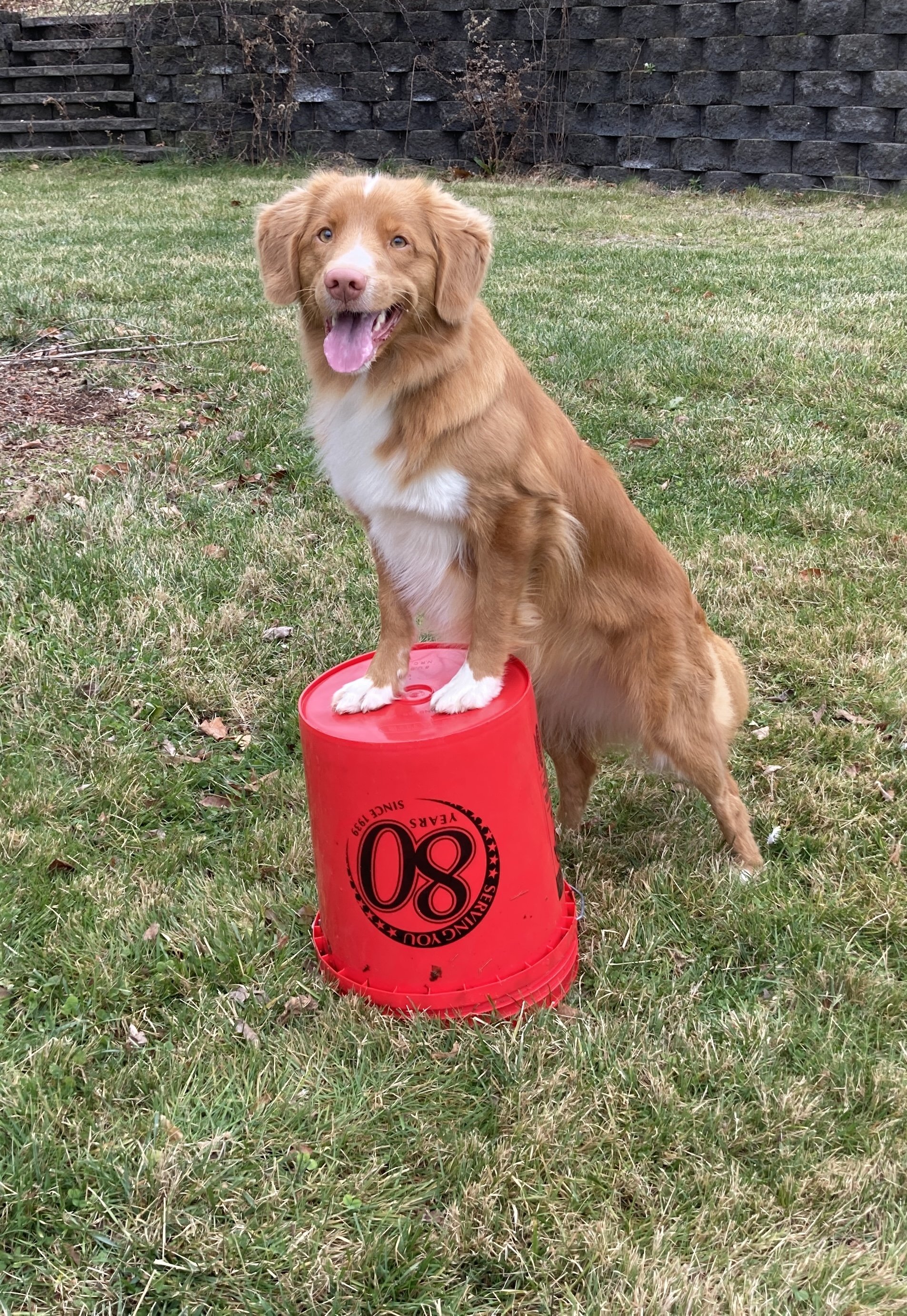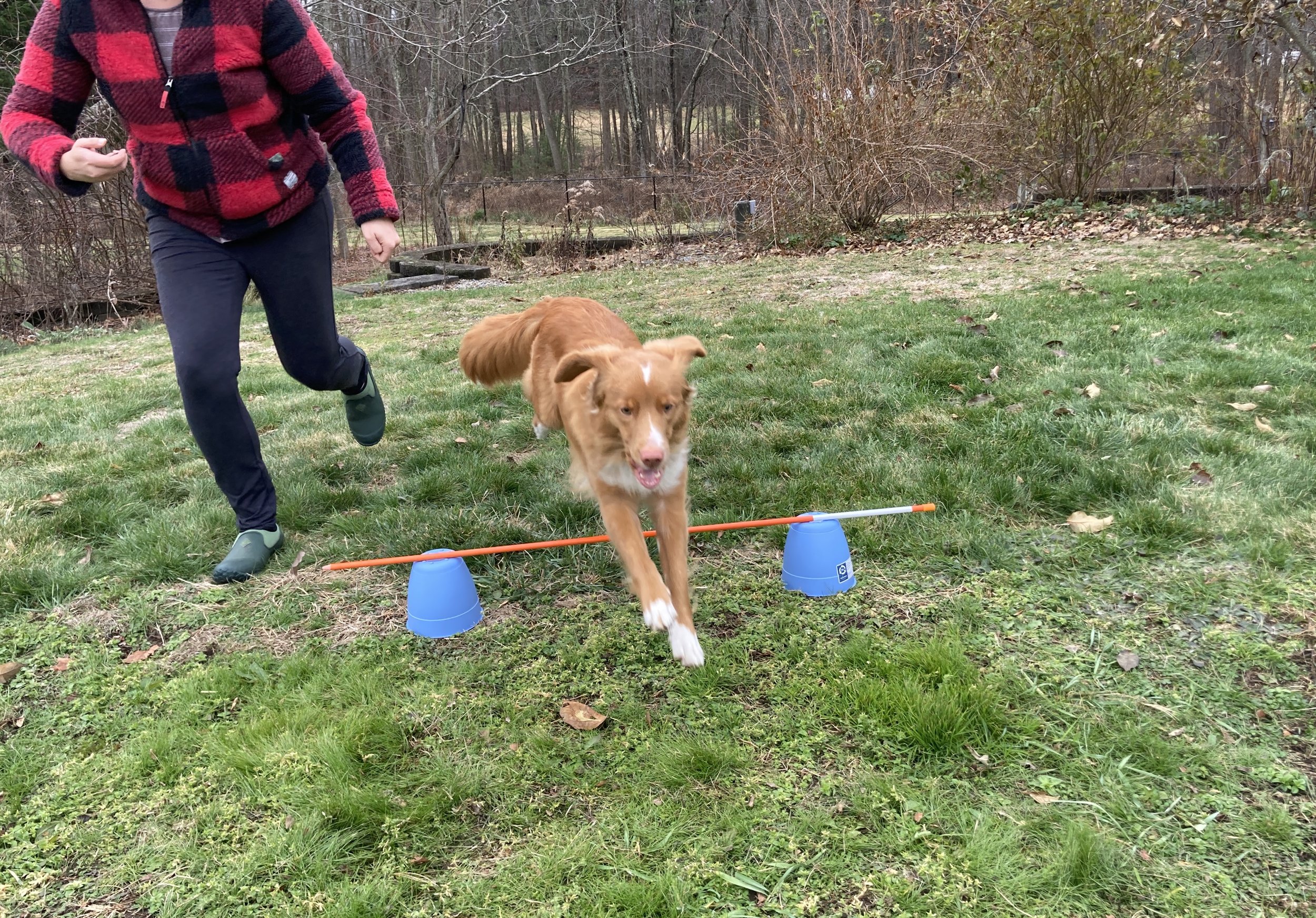Cheap & DIY Dog Agility Equipment Hacks
Agility is a great way to bond with your dog and build confidence. The problem? It’s an expensive sport requiring specialized equipment! Here are some options for getting started with space-friendly cheap and DIY dog agility equipment hacks.
Have you ever seen top agility dogs blast through a complicated course in under 30 seconds? These canine athletes and their handlers spend years training and traveling all over the country (or even the world!) to compete. Most teams will never get to that level of skill and speed, but that doesn’t mean you can’t enjoy training in agility with your dog!
Getting into agility is expensive. Classes, trial entries, travel, and equipment costs–it all adds up. But if you want to just try it out with your pup and give them another outlet for their body and brain, you don’t have to spend a lot or have much space to work with. You can practice a lot of foundational agility skills with DIY dog agility equipment hacks, using things most people already have on hand.
DIY Dog Agility Jumps
Jumps are pretty easy to set up, using things you might already have in your home. A light pole, like a length of PVC pipe, a snow/garden stake, or a dowel can be your bar. Then, you just need two supports on either side to prop the bar up. Laundry baskets, boxes, plastic flowerpots–anything, really!
It’s best to start low and work your way up, especially if you have a young puppy. Jumps should be kept low while puppies are still growing. As they reach adulthood and get more confident, you can gradually raise the bar.
For safety, it’s a good idea to have your bar “free” (resting on top of the props you’re using) so it will fall to the ground if your pup knocks into it. This is how real agility jumps are set up, since dogs can injure themselves if they catch a bar and the bar doesn’t move!
Another safety tip is to make sure your bar is visible to your dog. A green garden stake will disappear against grass, making it difficult for your pup to know when to jump. When constructing your DIY dog agility jumps, you might need to wrap your bars with contrasting tape to make them easy to see.
Agility Table Hacks
The table is a common obstacle in some agility organizations, and it can also help you prep for obstacles that require a dog to climb with four paws, like the dog walk, a-frame, and teeter-totter.
You can rig up a “table” with nothing more than a couch cushion or an ottoman. Teaching your dog to hop up on the cushion will help improve body awareness and help get them comfortable with unstable surfaces. If your dog is on the lighter side, you can also use a low, flipped-over plastic storage tub.
Options for Building Tunnel Skills
Most dogs love going through tunnels, once they get the hang of it. Even if you don’t have the budget or space for an agility tunnel, you can practice these skills by teaching your dog to crawl under a chair or a low table.
Depending on your dog’s size, you might also be able to use a children’s play tunnel, or even a cat tunnel for very small dogs. You might need to weigh your tunnel down with some sandbags if your puppy is enthusiastic about the assignment!
Dog Walk Alternative: Narrow, Low Walls
The dog walk is one of the biggest and most expensive agility obstacles. It can also be dangerous, since dogs have to run across a narrow plank and avoid misplacing their feet.
It’s not practical for most people to buy and store their own dog walk, but you can still practice the skills needed for the obstacle by finding a low, narrow wall like a retaining wall. Having your pup practice walking along a wall will help them improve their balance and increase their body awareness. If you ever decide to take an agility class, your pup will already be a pro at walking on narrow surfaces!
Dog Agility Teeter-Totter Prep
The teeter-totter can be one of the most challenging obstacles for dogs to learn. After all, it’s scary when the ground gives way under your feet and you aren’t expecting it! Puppies who learn to run and play on unstable surfaces, however, often have a lot more confidence on the teeter-totter.
Wobble boards, logs in the woods, and inflatable fitness equipment are all awesome ways to get your pup used to unstable surfaces–and even enjoy them. Bring your puppy to dog-friendly stores and get them used to riding on a hand cart, set a board on top of some blankets for them to climb–give your puppy all kinds of opportunities to build their confidence while setting them up for success!
Other Tips for DIY Dog Agility Success
The hacks above are just a few ideas for how you can build agility skills at home on the cheap (and without needing a huge yard), but there are lots of other ways you can build DIY obstacles, whether you want to start making your own PVC and wood equipment (there are tons of tutorials) or just stick to what you can make with household items. Get creative! Keep the following tips in mind for even more DIY dog agility success.
Check Out Inexpensive Children’s Fitness Equipment (and Try the Dollar Store!)
In many cases, fitness equipment for kids and adults is very similar (or identical) to equipment made for dogs–but at a fraction of the price. You can buy cones, balance discs, wobble boards, platforms, and other small pieces of fitness equipment cheaply.
Try checking the dollar store and hardware store for things you can use to teach agility skills. You can teach your pup to run around a large plastic bucket (or put their paws up on it) and pick up children’s games that can be used for other obstacles, like a “giant croquet” set found for 50% off at 5 Below, which can be used to make hoops used in some agility organizations, if you have a yard. Even items like a ladder on the ground can be used to improve your pup’s agility skills. There are tons of possibilities!
Prioritize Body Awareness
Surprisingly, most pups don’t learn how to back up or use their back legs independently from their front legs without being taught! Body awareness exercises can help prevent injury, build muscle and confidence, and help dogs understand how their movements can be used to navigate different spaces.
Body awareness is an important skill for puppies to learn, whether they are going to compete in agility or not. Skills like backing up, pivoting, and balance are all important for building body awareness.
Always Put Safety First!
Many puppies (and even adult dogs!) are pretty reckless when it comes to their own personal safety. As the human, it’s up to you to set up safe opportunities for your pup to exercise their body and brain. When putting together any DIY dog agility or fitness setup, be sure to evaluate any potential safety issues and adjust as needed before you begin. Be prepared to “spot” for your dog when needed!
Keep Puppy Workouts Low-Impact
Puppies are still growing, and it’s important for them to get lots of opportunities for low-impact play. High-impact activities, like higher jumps, weave poles, and other activities that can affect their growth should wait until they are fully grown. For larger puppies, that can take up to two or more years, while small dogs mature more quickly. Don’t worry–there’s a lot of safe foundation work and play you can do in the meantime that will be fun for both of you!
Start With Solid Foundations
Whether you think you want to take an agility class in person one day or not, you don’t need much in the way of equipment to teach solid foundational skills that are incredibly helpful. Whether you and your pup catch the agility bug or not, building these skills is great for your dog’s confidence, body awareness, and for bonding with you!
Want to learn key foundations for agility and fitness skills? Our AgiliPup course has you covered! Enroll in the next session to start learning exercises that will help your pup excel in the ring or just in your backyard!



